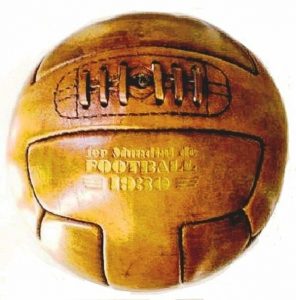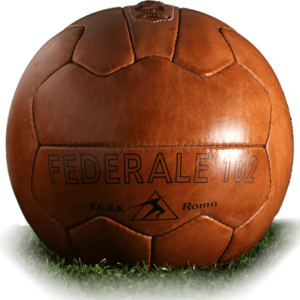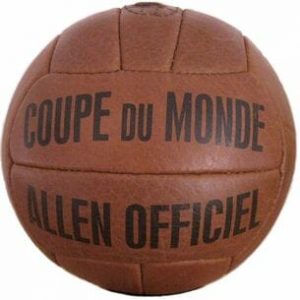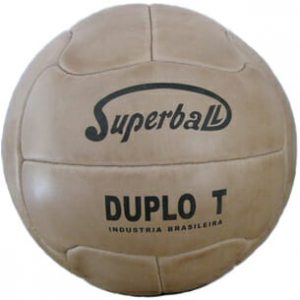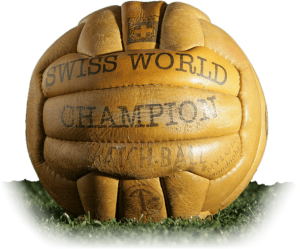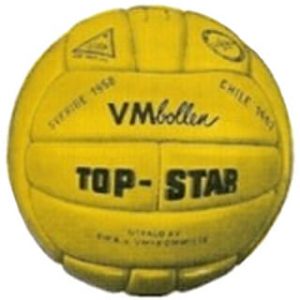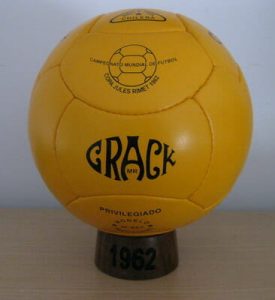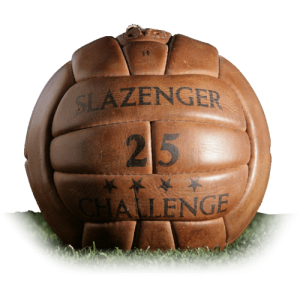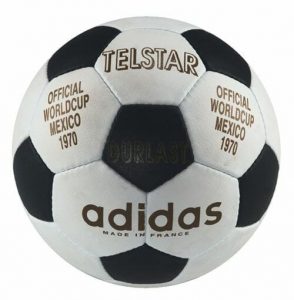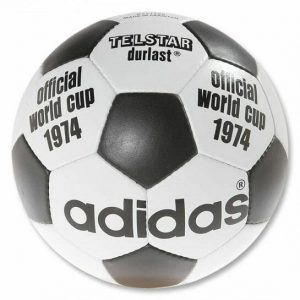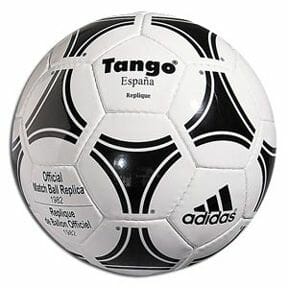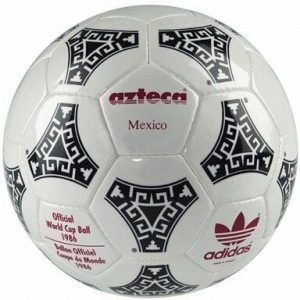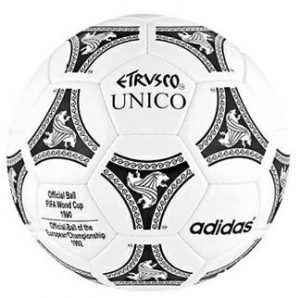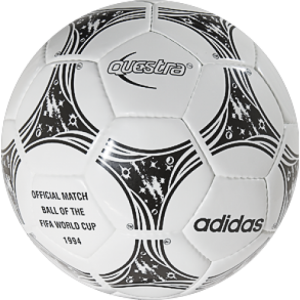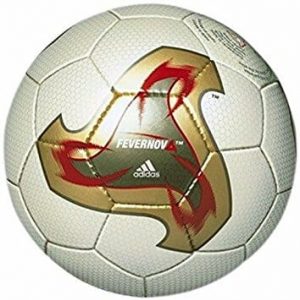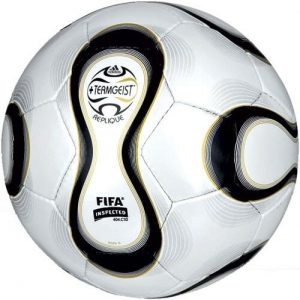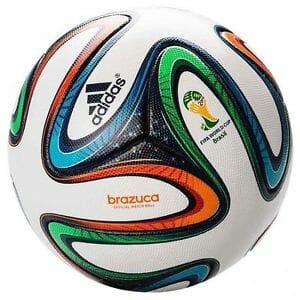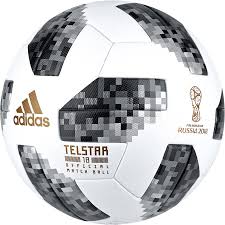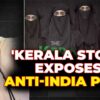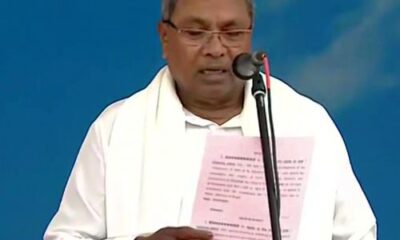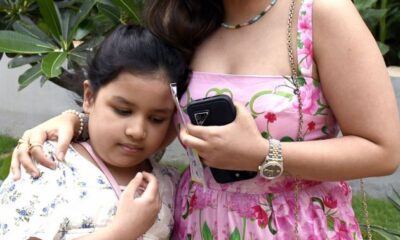Sports
History Of Official FIFA WORLD CUP Match balls
History Of Official FIFA WORLD CUP Match balls
Do you know that in every FIFA world cup a different ball is used and every ball has some interesting trivia closely associated with it?
Here we go:-
1930 FIFA World Cup
T-Model: The ball had a t-shaped panels,that’s why got its name T-Model. In the world cup finals Argentina chose the Tiento for the first half, while Uruguay chose the T-model in the second half. It was an all leather ball.
1934 FIFA World Cup
Federale 102: Italy dictator Benito Mussolini wanted the ball to be made in host nation Italy. So the ball was made in Italy as the leather laces were replaced with the cotton ones.
1938 FIFA World Cup
Allen: This was the first time a company’s brand was used to name the ball. A paris based manufacturer Allen designed the ball and so the ball got its name.
1950 FIFA World Cup
Duplo T: It was a first time that a FIFA ball could be inflated with a pump and a needle as laces were removed and valves were introduced.
1954 FIFA World Cup
Swiss World Champion: A 18-panel structure with panels interlocking in a zig-zag pattern was chosen and the design stayed on for the years to come.
1958 FIFA World Cup
Top Star: Fifa came up with an innovative idea of floating a competition among the manufacturers of the ball. 102 applied in the competition and a company in sweden was picked up to maufacture the ball.
1962 FIFA World Cup
Crack: Irregular division of panels made this ball quite unpopular among European players as the players thought that ball was manufactured in Chile.
1966 FIFA World Cup
Challenge 4-Star: A blind test was conducted by FIFA and a british company Slazenger was picked up to manufacture the ball. The ball had 25 panels.
1970 FIFA World Cup
Telstar: A revolutionary 32 panel black and white design was introduced by Adidas for the first time and the visibility of the ball was improved on Television because of it.
1974 FIFA World Cup
Telstar Durlast: It was a more or less of a same design as it was in 1970 as a polyurethane coating was used to waterproof the ball.
1978 FIFA World Cup
Tango: Black panels gave way for an all white base as Tango the best known dance form of Argentina was chosen.
1982 FIFA World Cup
Tango Espana: It was the last leather ball to be used in a world cup with improvements in the water resistance and durability of the ball. The design remained same as of 1978.
1986 FIFA World Cup
Azteca: It was a first fully synthetic ball to be used in the history of the world cup as the ball was able to retain its shape after being kicked.
1990 FIFA World Cup
Etrusco Unico: Etruscans an ancient civilization in Italy was honored as the ball was named Etrusco Unico. Etruscan Lions also made their way into the design because of this.
1994 FIFA World Cup
Questra: The ball was coated in a layer of Polystyrene foam which made it softer and easier to control and the ball also travelled much faster.
1998 FIFA World Cup
Tricolore: It was a first multicolored ball with the colors of a french national flag red, white and blue adorn the traids of the ball. The foam layer also made the ball softer.
2002 FIFA World Cup
Fevernova: The traditional Tango design was removed for the first time and two single enlarged triads were used. The background color also changed from white to champagne color.
2006 FIFA World Cup
Teamgeist: A more round shaped design with 14 panels and fewer seam was adopted for the first time and each match had its own individual ball.
2010 FIFA World Cup
Jabulani: Till date it remains the most controversial ball in the history of fifa world cup as its unpredictable behavior made the players very unhappy.
2014 FIFA World Cup
Brazuca: This time Adidas made sure to send the samples to players for testing before the cup. The ball was made from six polyurethane panels and did much better than Jabulani.
2018 FIFA World Cup
Telstar 18: The 1970’s classic Telstar model makes a return this time around with a latest panel design technology. This ball pays tribute to the first ever world cup ball from the Adidas.
The thermo-bonded Telstar 18 football features an NFC (near field communication) microchip that transmits information and promotes consumer interactivity utilizing smartphones.
Thermo-bonding technology uses heat to seamlessly patch panels, an improvement on stitching.

Al Rihla was a official matchball for FIFA Worldcup 2022 and in arabic it means, ’The Journey.’ The ball is produced by Adidas.
As Wikipedia puts it,”The ball contains a suspended inertial measurement unit inside its bladder that supplies the video assistant referee with instantaneous highly detailed ball movement data.”
Al Rihla was unveiled on March 30, 2022. If FIFA is to be believed then the visuals of the ball are inspired by the culture, architecture, boats and flag of Qatar. The blue, red, and yellow color scheme that is meant to represent the landscape of Qatar. On the “Pro” version of the ball one can read “Football is…” and all around “teamwork – fair play – collective – responsibility – passion – respect” in six languages: English, Arabic, Mandarin Chinese, French, Spanish, and Esperanto.
This article was last updated on 20-01-2023.
Sports
Harmeet, Anderson partnership helps USA stun Bangladesh in first T20I


Prairie View (USA), May 22 (IANS) Co-host United States of America caused a huge sensation ahead of the T20 World Cup, the Association Nation beating a full member Bangladesh by five wickets in the first T20I at the Prairie View Cricket Complex in Texas on Tuesday. Former Mumbai and India U-19 player Harmeet Singh scored an unbeaten 33 and shared a crucial partnership of 62 runs for the sixth wicket with former New Zealand all-rounder Corey Anderson (34 not out) as USA chased down the target after restricting Bangladesh to a modest total.
Electing to field first, the United States restricted Bangladesh to just 153/6 in 20 overs despite a half-century by middle-order batter Tawhid Hridoy, who scored 58 off 47 balls, hitting four boundaries and two sixes. Mahmudullah contributed a 22-ball 31 while Soumya Sarkar contributed 20 runs to the score.
Chasing a target of 154, the United States of America lost half of their team with just 94 runs as Mustafizur Rahman claimed 2-41 in four overs. He along with Shoriful Islam (1-21) and Rishad Hossain (1-16) caused the damage to the USA innings.
Opener Steve Taylor contributed 28 runs off 29 balls, hitting one four and one six but skipper Monank Patel was out for 12 runs. Andries Gous struck an 18-ball 23 runs to prop up the innings before they lost a couple of close wickets with Aaron Jones (4) and Nitish Kumar (10) departing in quick succession.
But the co-hosts found their heroes in Anderson and Harmeet Singh as they raised 62 runs for the unfinished sixth-wicket partnership.
Anderson played cautiously before hitting Mustafizur Rahman and Mahmudullah for a six each. Harmeet hammered back-to-back sixes off Mustafizur Rahman in the 17th over before hitting Shoriful Islam for a six in the 18th over and followed it up with a boundary off the last ball of the over. He sealed victory for the USA with a four off Mahmudullah off the third ball of the 19th over to seal victory.
Brief scores:
Bangladesh 153/6 in 20 overs (Towhid Hridoy 58, Mahmudullah 31; Steven Taylor 2-9) lost to the USA 156/5 in 19.3 overs (Corey Anderson 34 not out, Harmeet Singh 33 not out; Mustafizur Rahman 2-41) by five wickets.
–IANS
bsk/
Sports
Jofra Archer set for return in series-opener against Pakistan, confirms Buttler


Leeds, May 22 (IANS) England white-ball captain Jos Buttler has confirmed that speedster Jofra Archer will play in the first T20I against Pakistan on Wednesday. The pacer is making a comeback after more than a year-long injury lay-off. Archer’s back and elbow injuries made him miss cricket action for more than 12 months. The pacer was also struggling with the same injuries, which restricted him to playing seven matches in the last three years for England.
The 29-year-old pacer is raring to play for Three Lions after being picked in England’s 15-member provisional squad for next month’s T20 World Cup.
“He’s got a big smile on his face. It’s great to see him back, fit and bowling fast, and just being back around the group. I know how much he’s missed that. [Facing him] is never that fun, but he’s looking great,” ESPNcricinfo quoted Buttler as saying. “You have to temper expectations. He’s been out of international cricket for a long time, and you can never quite replicate that. We all know what a superstar he has been but manage those expectations: don’t expect too much too soon. He’s got such a high level of skill that he’s always going to perform well, but [he needs to] just enjoy being back playing cricket. As England captain and as a fan, people want to see him back enjoying his cricket,” he added.
Confirming his participation in the series opener, Buttler said the pacer’s workload will be managed in the four-match series. “He’s fully fit, and the medical team will advise how best to manage that. [He’ll play] as many as possible: he’s missed a lot of cricket and he’s desperate to get back out there and be a big part of the team,” the wicketkeeper said.
“Any player of Jofra’s calibre is a huge asset to any team. Absolutely, he makes us a better side and [gives us] a better chance of winning games. But we have to temper expectations, not put too much pressure on him, and ease him back in. The great success would be him coming through this series with a big smile on his face and his body holding up. That would be a success to me,” Buttler added.
Pakistan captain Babar Azam said his team is ‘excited’ to play Archer in the series. “As a team, we are very excited to play Archer. We have that pace of bowlers: Haris Rauf, [Mohammad] Amir, Shaheen [Afridi]. We are facing it every day. We are not [feeling] fear; we are excited,” he said.
–IANS
ab/bsk/
Sports
Football: Mauricio Pochettino and Chelsea agree to part ways after 2023-24 debacle


London, May 22 (IANS) Mauricio Pochettino and English club Chelsea have agreed to part ways with mutual consent, the Argentine coach’s tenure, which started on May 29, 2023, ended just a few days before the completion of a year. The club confirmed in a statement on Tuesday that both parties have mutually agreed to part ways.
“Thank you to the Chelsea ownership group and Sporting Directors for the opportunity to be part of this football club’s history. The Club is now well-positioned to keep moving forward in the Premier League and Europe in the years to come,” Pochettino said.
According to a media report, Pochettino agreed to his departure with Chelsea on Tuesday morning, following the club’s end-of-season review that started on Monday. Chelsea had finished sixth in the Premier League and failed to qualify for the European competitions, which eventually led to the end of the manager’s tenure.
The report claimed that there is no bad blood between the club and Pochettino as both have decided to agree on mutual terms. “On behalf of everyone at Chelsea, we would like to express our gratitude to Mauricio for his service this season. He will be welcome back to Stamford Bridge any time and we wish him all the very best in his future coaching career,” Sporting Directors Laurence Stewart and Paul Winstanley were quoted as saying in the statement.
Along with Pochettino, his support staff of Jesus Perez, Miguel d’Agostino, Toni Jimenez and Sebastiano Pochettino have also left the club.
The media report also claimed that the club has also started its search for a replacement for Pochettino with Stuttgart’s Sebastian Hoeness, Girona’s Michel, Ipswich Town’s Kieran McKenna, and Leicester City’s Enzo Maresca among those being considered among front-runners for the post.
–IANS
bsk/
Sports
IPL 2024: Starc, Shreyas, Venkatesh steer KKR into final after eight-wicket win over SRH


Ahmedabad, May 21 (IANS) Unbeaten half-centuries by captain Shreyas Iyer (58*) and Venkatesh Iyer (51*) guided Kolkata Knight Riders (KKR) to a crushing eight-wicket win over Sunrisers Hyderabad (SRH) in Qualifier 1 and place in the final of the Indian Premier League (IPL) 2024 at Narendra Modi Stadium here on Tuesday.
Hyderabad will have another chance to face KKR in the final as they will next take on the winner of the Eliminator match between Rajasthan Royals and Royal Challengers Bengaluru in Chennai on Friday.
Chasing 160, openers Rahmanullah Gurbaz and Sunil Narine gave KKR an electric start in the Powerplay overs as the due scored runs at a run rate of over 10 runs per over.
The first-wicket partnership lasted for 44 runs in 20 balls before T. Natrajan made inroads in the fourth over. The pacer removed Gurbaz at the score of 23 to bring the side back in the game after the thundering start in the chase.
Venkatesh Iyer joined Narine in the middle and kept the momentum going as they added 23 runs before Pat Cummins got Narine (21) in his first over into the attack just after the powerplay.
Shreyas Iyer walked out to bat at No. 4 and built the match-winning partnership for the side that allowed them to chase the total with 38 balls to spare.
Shreyas (58*) and Venkatesh (51*) accumulated an unbeaten 97-run partnership for the third wicket and also smashed their individual fifties during the successful run-chase. Both players hit four sixes and five fours each as they went berserk to take their side to the final.
Earlier, KKR restricted Sunrisers Hyderabad to 159 all out in 19.3 overs after the latter decided to bat first.
Hyderabad did not get the ideal start of the match as they lost attacking opener Travis Head again for a duck. Things got worse well inside the Powerplay as they lost three more wickets in the first six overs.
Pacer Mitchell Starc was on a roll as he got three of the four wickets in the powerplay. Abhishek Sharma (3), Nitish Reddy (9). and Shahbaz Ahmed (0) were picked cheaply as Hyderabad’s batters faltered in the high-pressure game. SRH were 45/4 after six overs.
However, Rahul Tripathi and Heinrich Klaasen’s presence in the middle gave some respite for the franchise as they played their shots freely despite being under pressure. The duo stitched a quickfire 62-run partnership off 37 balls as Tripathi struck a 29-ball fifty before Varun Chakaravarthy broke the partnership in the 11th over. Klaasen departed after playing a knock of 32 runs.
Abdul Samad joined Tripathi to further boost the score but a mix-up in the middle of the pitch ended the latter’s innings on 55. His knock included seven fours and a six. In the late middle overs, SRH failed to recover from the situation and kept on losing wickets as Sunil Narine and Harshit Rana also joined the party for KKR. In the end, captain Pat Cummins played a cameo knock of 30 runs off 24 balls to take his side past the 150-run mark. His late effort was put to an end by Andre Russell in the final over of the innings.
For KKR, Starc was the pick of the bowlers, returning with figures of 3-34 while Chakaravarthy snapped two scalps.
Brief scores:
Sunrisers Hyderabad 159 all out in 19.3 overs (Rahul Tripathi 55, Heinrich Klaasen 32; Mitchell Starc 3/34, Varun Chakaravarthy 2-26) lost to Kolkata Knight Riders 164/2 in 13.4 overs (Shreyas Iyer 58*, Venkatesh Iyer 51*; T. Natarajan 1-22) by eight wickets.
–IANS
ab/bsk/
Sports
Euro 2024: No Rashford as Southgate names 33-man preliminary England squad


London, May 21 (IANS) England coach Gareth Southgate produced a surprise on Tuesday when he named his preliminary squad for the forthcoming European Championships (Euro 2024) when he left out Manchester United forward Marcus Rashford. The absence of Rashford, who has 17 goals in 60 appearances for England, is the biggest surprise in the 33-player squad (which has to be reduced to 26 by June 7), which is also without veteran midfielder Jordan Henderson and central defender Eric Dier, who has been in excellent form for Bayern Munich.
Southgate has included Manchester United left-back Luke Shaw, despite him not playing since February, but with no Ben Chilwell in the squad, if Shaw isn’t fit enough to make the final cut, England will go into the tournament without a specialist left-back.
“I just feel other players in other areas of the pitch have had better seasons,” said Southgate when asked about Rashford’s absence.
Everton’s exciting young defender Jarrad Branthwaite and Liverpool defender Jarell Quansah are both in the squad, along with Joe Gomez, who could be an option at left-back if Shaw isn’t fit.
The 20-year-old midfielder Adam Wharton is also given a chance after impressing following his move from Blackburn Rovers to Crystal Palace in January.
Meanwhile, Aston Villa’s Ollie Watkins and Brentford forward Ivan Toney have been given a call-up, with Toney perhaps lucky to be preferred to Bournemouth forward Dominic Solanke, who ended the season with 19 goals in the Premier League.
“There’s definitely much more attacking options than compared to other squads,” commented Southgate, who was also happy his players had more “tournament experience.”
“We’re really happy with where the squad is at. But everything starts from zero. It doesn’t matter what we’ve done in the past,” he added.
Full squad:
Goalkeepers: Dean Henderson, Jordan Pickford, Aaron Ramsdale, James Trafford.
Defenders: Jarrad Branthwaite, Lewis Dunk, Joe Gomez, Marc Guehi, Ezri Konsa, Harry Maguire, Jarell Quansah, Luke Shaw, John Stones, Kieran Trippier, Kyle Walker.
Midfielders: Trent Alexander-Arnold, Conor Gallagher, Curtis Jones, Kobbie Mainoo, Declan Rice, Adam Wharton.
Forwards: Jude Bellingham, Jarrod Bowen, Eberechi Eze, Phil Foden, Jack Grealish, Anthony Gordon, Harry Kane, James Maddison, Cole Palmer, Bukayo Saka, Ivan Toney, Ollie Watkins.
–IANS
bsk/
-
Video1 year ago
PM Modi Attacks Congress in Karnataka with “Kerala Story”
-
Cricket12 months ago
CSK players rejoice 5th IPL title with their families (Pics)
-
Politics1 year ago
Siddaramaiah & DK Shivakumar sworn in as Chief Minister & Deputy CM respectively
-
Entertainment11 months ago
Karan Deol weds his longtime Girlfriend Drisha Acharya (Pics)
-
Entertainment1 year ago
Urvashi Rautela dazzles on Cannes 2023 red carpet (Pics)
-
Entertainment12 months ago
Sunny Leone gets ready for Kennedy premiere in Cannes (Pics)
-
Entertainment1 year ago
Alia Bhatt looks crazy beautiful in Prabal Gurung creation at MET GALA 2023 (Pics)
-
Cricket1 year ago
Sakshi & Ziva Dhoni enjoy their time during CSK VS MI match

